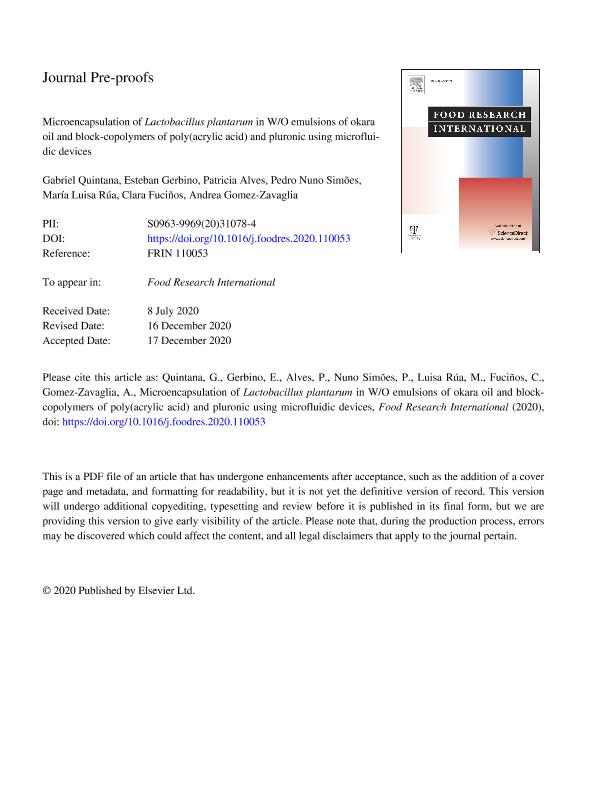Artículo
Microencapsulation of Lactobacillus plantarum in W/O emulsions of okara oil and block-copolymers of poly(acrylic acid) and pluronic using microfluidic devices
Quintana, Gabriel Sebastian ; Gerbino, Oscar Esteban
; Gerbino, Oscar Esteban ; Alves, Patricia; Nuno Simões, Pedro; Rúa, María Luisa; Fuciños, Clara; Gomez Zavaglia, Andrea
; Alves, Patricia; Nuno Simões, Pedro; Rúa, María Luisa; Fuciños, Clara; Gomez Zavaglia, Andrea
 ; Gerbino, Oscar Esteban
; Gerbino, Oscar Esteban ; Alves, Patricia; Nuno Simões, Pedro; Rúa, María Luisa; Fuciños, Clara; Gomez Zavaglia, Andrea
; Alves, Patricia; Nuno Simões, Pedro; Rúa, María Luisa; Fuciños, Clara; Gomez Zavaglia, Andrea
Fecha de publicación:
02/2021
Editorial:
Elsevier Science
Revista:
Food Research International
ISSN:
0963-9969
Idioma:
Inglés
Tipo de recurso:
Artículo publicado
Clasificación temática:
Resumen
Okara oil is a by-product remaining from defatting okara, the solid residue generated after extracting the aqueous fraction of grounded soybeans in the elaboration of soy beverages. The goal of this work was to encapsulate the probiotic Lactobacillus plantarum CIDCA 83114 into W/O emulsions composed of a block-copolymer constituted of pluronic® and acrylic acid (PPP12) and okara oil, prepared in microfluidic devices. For comparative purposes, alginate was also included as a second dispersed phase. Lactobacillus plantarum CIDCA 83114 was suspended in PPP12 or alginate giving rise to dispersed phases with different compositions, named I, II, III and IV. Controls were prepared by suspending microorganisms in water as dispersed phase. 6-carboxyfluorescein was added as bacterial marker in all the emulsions. The presence of green dyed bacteria in the dispersed phases, inside the droplets of the emulsions and the absence of fluorescence outside them, confirmed the complete encapsulation of bacteria in the dispersed phases. After being prepared, emulsions were freeze-dried. The exposure to gastric conditions did not lead to significant differences among the emulsions containing polymers. However, in all cases bacterial counts were significantly lower than those of the control. After exposing emulsions to the simulated intestinal environment, bacterial counts in assays I, II and III (emulsions composed of only one dispersed phase or of two dispersed phases with bacteria resuspended in the PPP12 one) were significantly greater than those of the control (p < 0.05) and no detectable microorganisms were observed for assay IV (emulsions composed of two dispersed phases with bacteria resuspended in the alginate one). In particular, bacterial cultivability in emulsions corresponding to assay I (only PPP12 as dispersed phase) exposed to the intestinal environment was 8.22 ± 0.02 log CFU/mL (2 log CFU higher than the values obtained after gastric digestion). These results support the role of PPP12 as an adequate co-polymer to protect probiotics from the gastric environment, enabling their release in the gut, with great potential for food or nutraceutical applications.
Archivos asociados
Licencia
Identificadores
Colecciones
Articulos(CIDCA)
Articulos de CENTRO DE INV EN CRIOTECNOLOGIA DE ALIMENTOS (I)
Articulos de CENTRO DE INV EN CRIOTECNOLOGIA DE ALIMENTOS (I)
Citación
Quintana, Gabriel Sebastian; Gerbino, Oscar Esteban; Alves, Patricia; Nuno Simões, Pedro; Rúa, María Luisa; et al.; Microencapsulation of Lactobacillus plantarum in W/O emulsions of okara oil and block-copolymers of poly(acrylic acid) and pluronic using microfluidic devices; Elsevier Science; Food Research International; 140; 2-2021; 1-29; 110053
Compartir
Altmétricas



